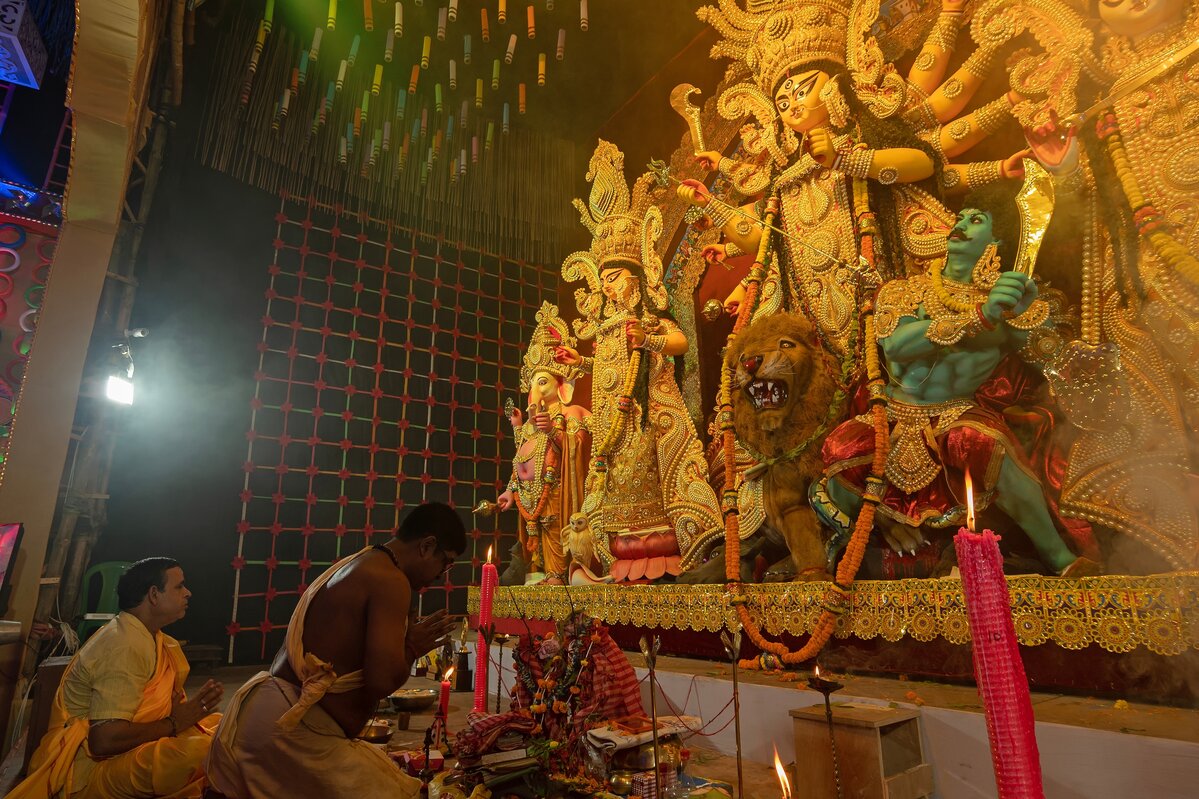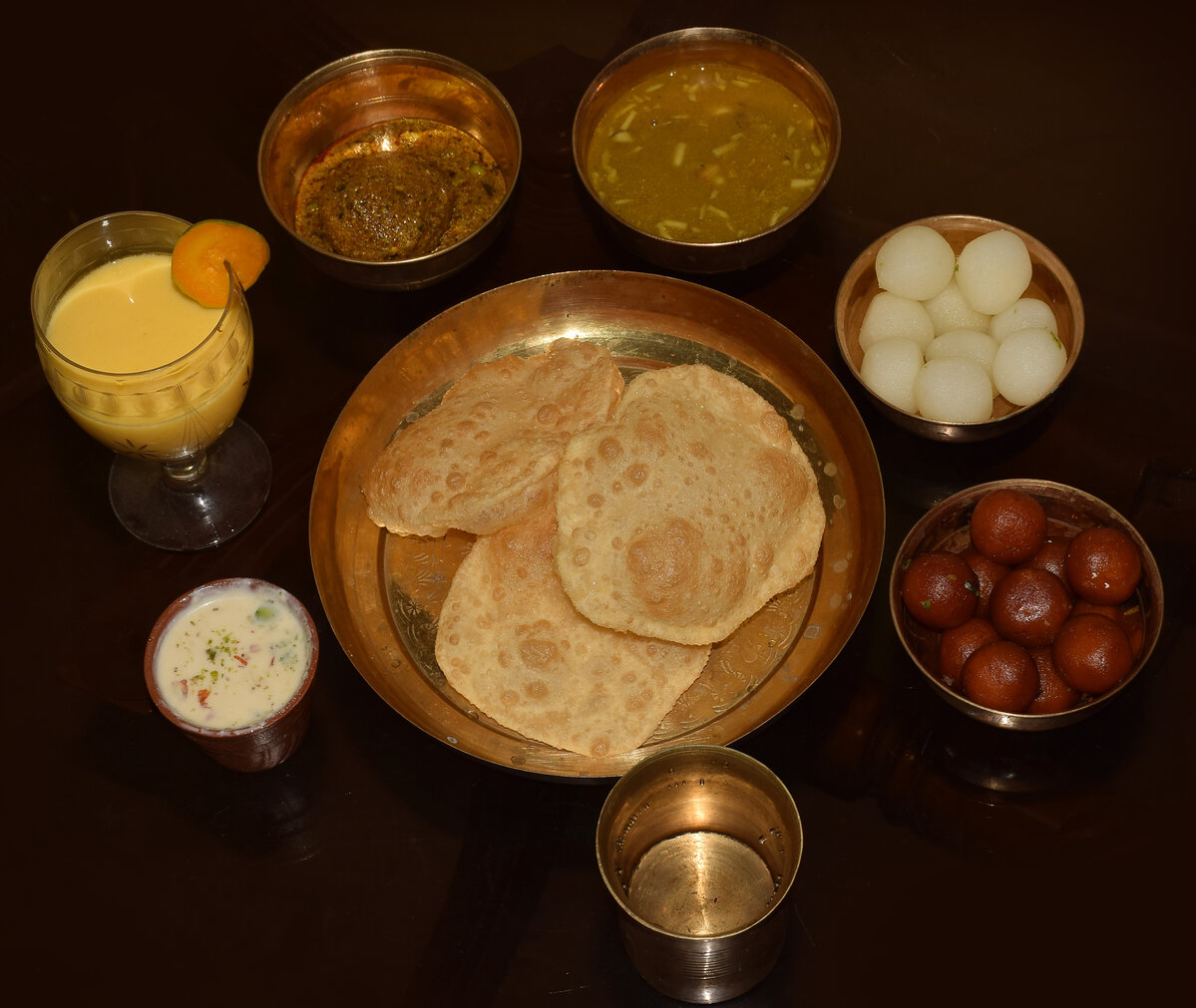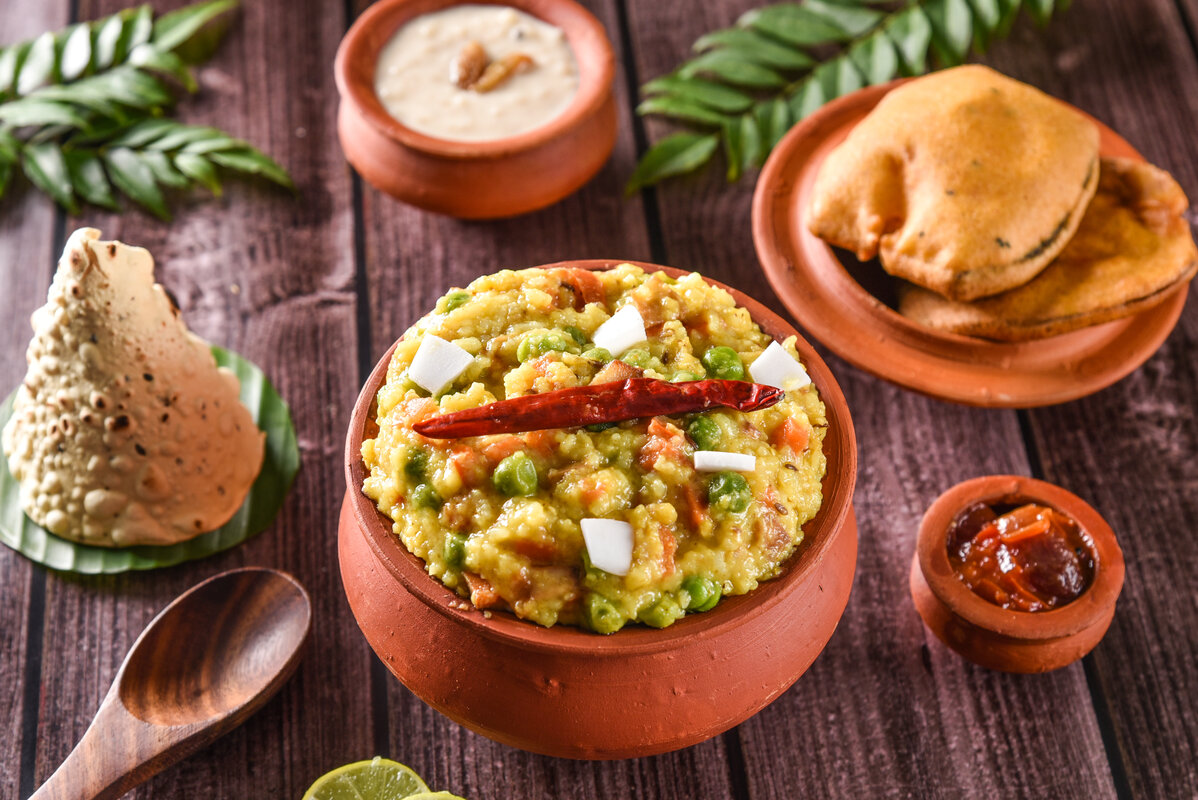September 26, 2025
The Bengali Feast During Durga Puja: A Sacred Culinary Homecoming
CM Content Team


View all
140+
Resorts
September 26, 2025
CM Content Team
In Bengal, the arrival of Sharad Durga Puja is not merely a religious event, it is a season of beauty, celebration, and profound emotion. For Bengalis, Durga is more than a goddess. She is a daughter returning home, accompanied by her children, visiting her maternal abode for five sacred days. With her arrival, homes, neighbourhoods, and communities come alive. Amid the chants, dhaak beats, vermilion trails, and clay idols, there exists one deeply personal tradition that ties it all together: the Bengali feast.
This feast is not only a matter of ritual; it is an offering of love. Since Bengal is a land of rivers and fertile plains, food is central to its identity. Fish and non-vegetarian food are not considered indulgences but staples, woven into the very culture of the region. Therefore, when Maa Durga returns home, she is treated to the best that comes from the river and from the land.
From Sashti (the sixth day of Navratri) to Dashami (the tenth and final day), Bengali kitchens transform into sacred spaces. Each meal, especially the bhog (ritual offering), is carefully curated to reflect not just tradition, but care and devotion. The feast becomes a language of affection, a daughter is being hosted, and her plate must reflect her family’s best.

Unlike other festivals where fasting or abstinence plays a central role, Durga Puja in Bengal is a celebration of abundance. Devotees express their love not through denial but through offering. The cooking process, chopping, stirring, seasoning, becomes sacred. Kitchens become temples; recipes become rituals.
The unique aspect of Bengali Durga Puja lies in how intimately the goddess is regarded. She is not a distant deity to be feared or pleased with grandeur. She is a daughter, returning to her maternal home. And what does a mother do when her daughter comes home? She cooks with all her heart. The feast is not just food, it is care, warmth, emotion plated for a loved one. The kitchen transforms into a sanctuary of love, where every spice is a memory and every stir a silent prayer.
From mustard-rich fish to delicate payesh, the Durga Puja menu is a canvas of Bengal’s culinary art. It incorporates ingredients that are native, seasonal, and rooted in history. Local vegetables, fresh river fish, rice, lentils, and handmade sweets come together to create not only nourishment but identity. It is a celebration of the region’s resources and memories. Each dish carries whispers of grandmothers’ kitchens, age-old recipes passed down through generations. The feast becomes a living archive, preserving flavours that define Bengali soul. In every bite, one tastes the soil, the river, and the rhythm of a culture in celebration.
The bhog, once offered to the goddess, is distributed as prasad to the entire community. In this act, social lines blur, everyone partakes, regardless of class, creed, or background. Food becomes a unifying force. There are no invitations, no reservations, only the open-hearted spirit of giving. In that moment, the goddess is not only worshipped, she is truly lived through shared humanity.
The Durga Puja feast is a rich, sensory experience that stays with you. The smell of hot luchis in ghee, the bright colours of vegetable dishes, the sound of ladles stirring dal, the soft feel of steamed rice, and the sweet taste of jaggery desserts all come together in a way that feels both joyful and sacred. It’s more than just a meal; it’s a moment of love and devotion on every plate. .

Each day of the festival brings its own emotional arc, and its own menu. From the gentle welcome on Sashti to the humble goodbye on Dashami, the feast evolves in complexity and emotion.
Purpose: The goddess arrives. The mood is gentle and hopeful.
Bhog:
Emotional Context:
The goddess is welcomed home like a daughter who’s been away too long. The menu is modest but comforting, symbolizing care over opulence.
Purpose: The worship formally starts. The feast becomes slightly more elaborate.
Bhog:
Family Additions:
Emotional Context:
Saptami is about initiation. The offerings begin to reflect more confidence, more flavours, but still carry a gentle tone.
Purpose: Spiritually the most significant day. Worship is intense, and so is the feast.
Bhog:
Family Additions:
Emotional Context:
Ashtami represents the peak of celebration. The dishes become more elaborate, reflecting deep reverence and emotional fullness.
Purpose: The goddess’s stay is nearing its end. The feast reflects indulgence.
Bhog / Offerings:
Family Additions:
Emotional Context:
Navami is festive and bold. It is believed that the goddess accepts the most elaborate offerings today. The food is rich, hearty, and deeply satisfying, a daughter’s favourite spread before her departure.
Purpose: The goddess departs. A heartfelt, humble offering is made.
Offerings:
Emotional Context:
This is the day of parting. The food is humble and filled with emotion over extravagance. Offering simple fish and greens is a symbolic farewell meal.
When regarded as a daughter, the offerings made to Maa Durga carry a different significance. They are not ceremonial for ceremony’s sake; they are deeply personal. Some ideal foods include:
These dishes are more than food, they are memories, identity, and love on a plate.

If one wants to taste these Bengali delights in a premium setting, Club Mahindra resorts often deliver exceptional culinary experiences. Their in‑resort restaurants combine local flavours with fine dining, serving regional classics with elegance and care.
During festival seasons, Club Mahindra Restaurants feature special menus giving guests a chance to enjoy dishes of that culture.
With a Club Mahindra membership, families unlock access to over 140+ Club Mahindra resorts across India and abroad, including scenic destinations steeped in culture. Members enjoy easy and flexible holiday bookings, curated experiences, and the comfort of home wherever they go. Whether it’s a festive getaway or a relaxing retreat, Club Mahindra ensures every stay is memorable. It’s not just a holiday, it’s a lifetime of unforgettable vacations.
In Bengal, Durga Puja is not simply a festival, it is an emotional season. Through every dish cooked, stirred, offered, and shared, Bengalis tell their daughter: you are welcome, you are cherished, you are ours.
The feast, from Sashti’s soft khichuri to Dashami’s humble panta bhat, is a story. A story of arrival, celebration, abundance, and farewell. A story where the river flows into the plate, the soil is sautéed with spices, and every sweet is a prayer. For those who taste this feast, they do not just consume food, they taste devotion. And for those who cook it, every stir of the ladle is a way to say: “Maa, come again next year. We’ll have your plate ready.”
Mahindra Holidays & Resorts India Ltd. (MHRIL), a part of Leisure and Hospitality sector of the Mahindra Group, offers quality family holidays primarily through vacation ownership memberships and brings to the industry values such as reliability, trust and customer satisfaction. Started in 1996, the company's flagship brand ‘Club Mahindra’, today has over 300,000 members , who can holiday at 140+ resorts in India and abroad.
We use cookies to personalise content and to provide you with an improved user experience.By Continuing to browse this site you consent to the use of cookies.Please visit our cookie policy for further details.

Welcome to ClubMahindra.com In order to provide a personalised experience for you, we use cookies to enable some website functionality. Cookies help us see which articles most interest you; allow you to easily share articles on social media channels; permit us to deliver content personalised to your interests and locations; along with many other site benefits. For more information, please review our Cookie Policy
When you visit any website, it may store or retrieve information on your browser, mostly in the form of cookies. This information might be about you, your preferences or your device and is mostly used to make the site work as you expect it to. The information does not usually directly identify you, but it can give you a more personalized web experience. Because we respect your right to privacy, you can choose not to allow some types of cookies. Click on the different category headings to find out more and change our default settings. However, blocking some types of cookies may impact your experience of the site and the services we are able to offer.
Because we respect your right to privacy, you can choose not to allow some types of cookies and you have the right to withdraw your consent by send a mail to email id [email protected]
These cookies are essential in order to enable you to move around the site and use its features, such as accessing secure areas of the site. Without these cookies, services you have asked for cannot be provided.
These cookies allow us to employ data analytics so we can measure and improve the performance of our site and provide more relevant content to you. These cookies don't collect information that identifies a visitor down to an individual level that is available to us. These cookies are not passing personally identifiable information to any external third party other than in limited cases when we engage a service provider to act on our behalf but who is then unable to use the data for their own purposes.
Performance cookies are generally third-party cookies from vendors we work with or who work on our behalf that collect information about your visit and use of the Club Mahindra website, for instance which pages you visit the most often, and if you get error messages from web pages. These cookies don't collect information that identifies a visitor. All information these cookies collect is anonymous and is only used to improve your overall experience on how the website works. Third party vendors may have access to this data and may use it to improve their overall services and offerings.
Functionality cookies allow a site to remember choices you make (such as your user name, language or the region you are in) and provide more enhanced, personal features. These cookies cannot track your browsing activity on other websites. They don't gather any information about you that could be used for advertising or remembering where you've been on the Internet outside our site.
Third-party advertising and social media cookies are used to (1) deliver advertisements more relevant to you and your interests; (2) limit the number of times you see an advertisement; (3) help measure the effectiveness of the advertising campaign; and (4) understand people's behaviour after they view an advertisement. They are usually placed on behalf of advertising networks with the site operator's permission. They remember that you have visited a site and quite often they will be linked to site functionality provided by the other organization. This may impact the content and messages you see on other websites you visit. If you do not allow these cookies you may not be able to use or see certain these sharing tools content on our website.